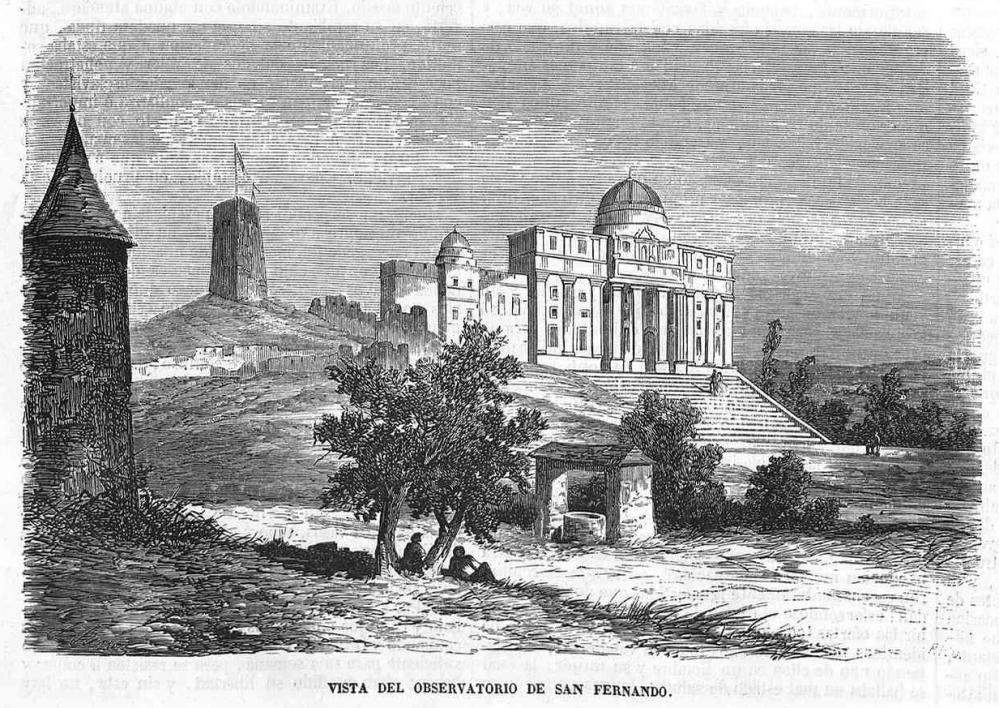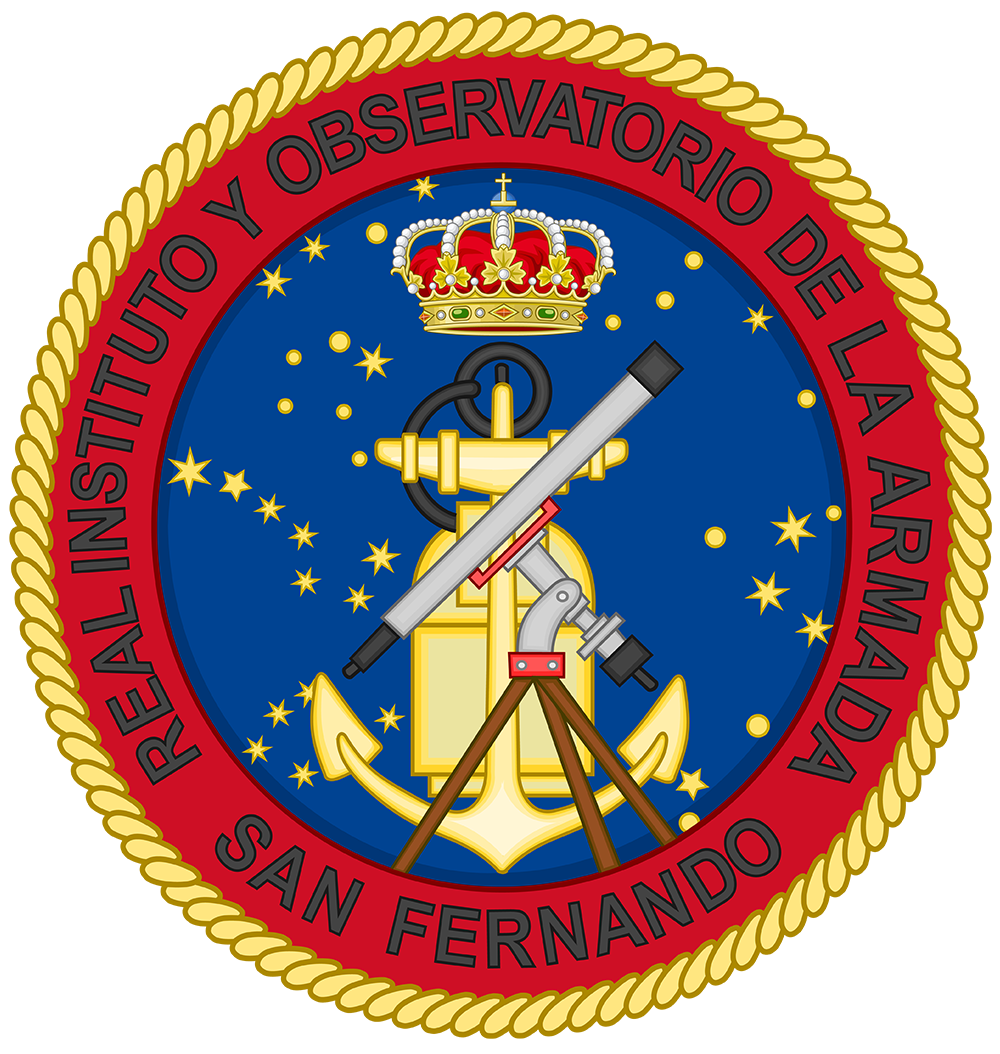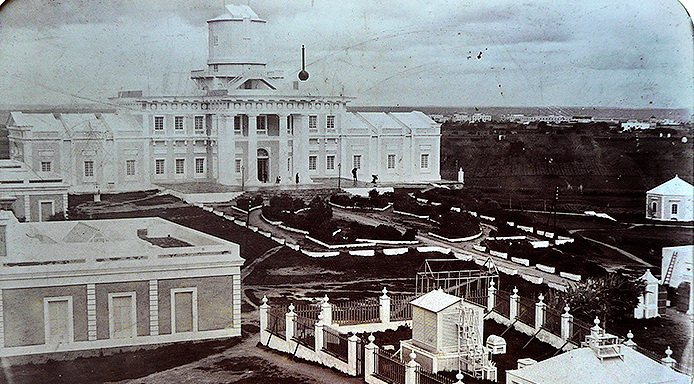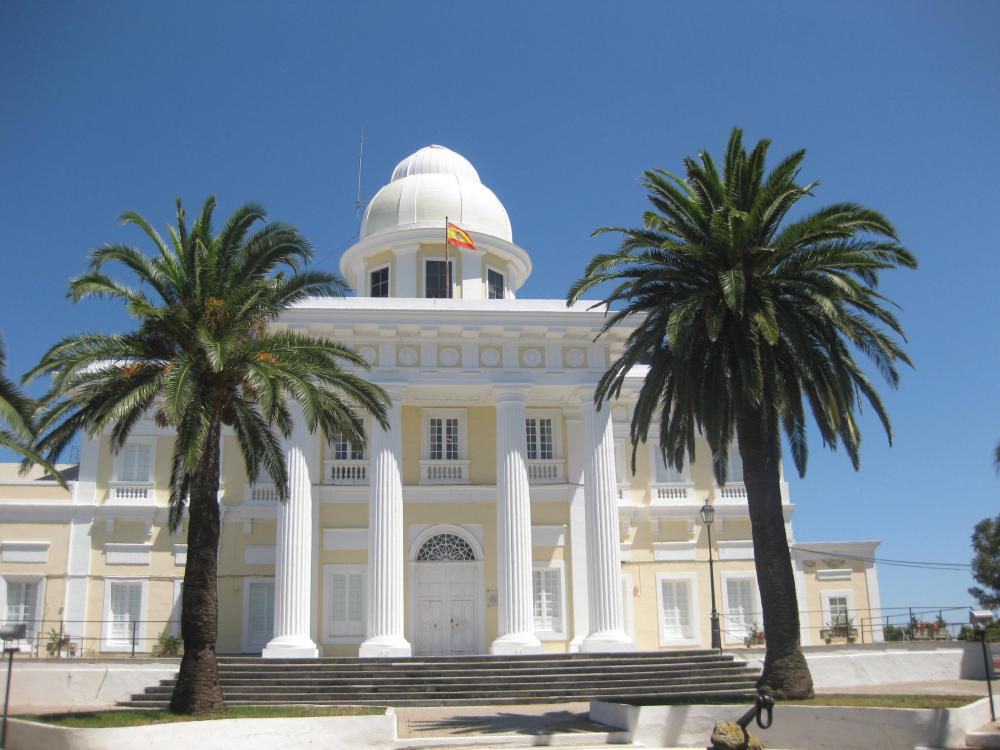
Category of Astronomical Heritage: tangible immovable
Real Instituto y Observatorio de la Armada de San Fernando, Cádiz, Spain

Description
Geographical position
Royal Institute and Astronomical Observatory of the Spanish Navy, San Fernando, Província de Cádiz, Andalusia, Spain
Location
Latitude 36°27’54’’N, Longitude 6°12’21’’W, 30m
IAU observatory code
983
Description of (scientific/cultural/natural) heritage

Fig. 1. Real Instituto y Observatorio de la Armada de San Fernando (Wikipedia)
The Real Instituto y Observatorio de la Armada de San Fernando is the oldest observatory in Spain and one of the oldest state observatories in the world.
In 1753 the Royal Observatory was founded by the Jorge Juan y Santacilia (1713--1773), Head of the Naval Academy in the Andalusian port city of Cádiz, in order to teach future naval officers about astronomy - essential for navigation.
The observatory is designed by the Marquis of Ureña in neoclassical style - a distinguished military architecture to house the headquarters of the Cadiz Maritime Department. The astronomical observatory is a singular landmark of enlightened Spain, not only for its scientific achievements, but also for its architectural values (Martinez Monttel 1989, p. 9).

Fig. 2. Emblem of the Royal Institute and Observatory of the Spanish Navy (Wikipedia 3, Heralder) (Wikipedia)
The main task was time keeping, setting the official time in Spain. As a naval observatory, located on the hill of Torre Alta, from which you could see the ocean, it operated a time ball (1878), announcing the exact time to the ships for navigation (for synchronizing their clocks).
The astronomy department has been used for the observation and theoretical study of the positions of the stars and celestial bodies in the solar system; the results, the ephemeris for the Navy were published in the Astronomical Yearbook and Astronomical Ephemeris.
The astronomy department is divided into three areas: area-wide astrometry, solar astronomy and meridian astrometry.
The research topics were besides astronomy and time keeping also earth sciences, geophysics, geomagnetism, seimology, meteorology and satellite services (tracking space junk with lasers). The Geophysics Department has been in continuous operation since 1879.
In 1790, the Real Observatorio de Madrid was built in order to take over the purely astronomical work of San Fernando.
History

Fig. 3. Federico Ruiz: View of the Real Instituto y Observatorio de la Armada de San Fernando in the mid-19th century (El Museo Universal, 1861) (Wikipedia 4, Sobreira)
Instruments
- Mural circle, Thomas Jones (1834)
- Theodolit, Ertel & Sohn, Munich (1880)
- Transit instrument
- Meridian circle, Troughton & Simms (1859)
- Meridian circle, Grubb & Parsons of Newcastle (1948)
Carlsberg Automatic Meridian Circles (CAMC) (1987-1995), renamed Automatic Meridian Circle of San Fernando (CMASF) - moved in 1996 to Carlos Ulrrico Cesco Observatory, Observatorio Astronómico Félix Aguilar (OAFA), San Juan, Argentina - Astrograph, Gautier (Carte du Ciel and Astrographic Catalogue - in collaboration with the Centro de Investigaciones de Astronomía (CIDA), Venezuela)
- Astrolabe, Danjon

Fig. 4. Real Instituto y Observatorio Astronómico de la Armada de San Fernando (1886) (Wikipedia)
Cádiz Meridian
The Cádiz meridian, also known as the Zero meridian, governed all Spanish cartography from 1753 to 1884, when an international conference held in Washington established Greenwich as the first universal meridian. This meridian was established in 1753 thanks to the creation of the Royal Jorge Juan Observatory, which was
transfered to San Fernando in 1798, named Real Instituto y Observatorio de la Armada de San Fernando. This transfer forced a small change of the meridian: from 1801 the reference meridian for Spanish ships was that of San Fernando. The distance between the Cádiz meridian and the Greenwich meridian is 6┬║17’15’’ W.
State of preservation

Fig. 4. Real Instituto y Observatorio Astronómico de la Armada de San Fernando (Wikipedia 3, Normalita)
This oldest observatory in Spain is in perfect condition, but the appearance of the original building has undergone transformations throughout history.
It preserves a collection of ancient instruments an important historical heritage. Remarkable is the library comprising over 30,000 volumes, especially a cartographic collection, published between the 15th and 18th/19th centuries - a valuable scientific heritage.
Comparison with related/similar sites
The observatory is comparable with naval observatories time ball like Greenwich or the United States Naval Observatory Washington.
Threats or potential threats
no threats
Present use
The observatory is still in astronomical use. It is today a modern research institute that is dedicated to astronomy as well as geophysics and also provides the national time service.
Astronomical relevance today
The observatory uses laser technology for tracking space junk.
References
Bibliography (books and published articles)
- Atienza, Antonio: La bajada de la bola del Observatorio se escucha por martinete. Andalucía Información (2018-06-30) - in Spanish.
- González González, Francisco J.: Instrumentos científicos del Observatorio de San Fernando en los siglos XVIII, XIX y XX. Madrid: Ministerio de Defensa 1995, p. 1-286.
- González González, Francisco J. & Manuel Berrocoso: Instrumentos y trabajos geodésicos de la Armada: La Comisión Hidrográfica de la Península y el Observatorio de San Fernando (1859--1887). Madrid: Asclepio, Revista de Historia de la Medicina y de la Ciencia XLVII (1995), fasc. 1, p. 33-52.
- González González, Francisco J.: Péndulos astronómicos y cronómetros marinos de la Armada: El Observatorio de San Fernando y los antecedentes del Patrimonio Nacional de Tiempo (1753-1957). Madrid: Asclepio, Revista de Historia de la Medicina y de la Ciencia L (1998), fasc. 1, p. 175-198.
- González González, Francisco J.: La colección de instrumentos antiguos del Real Instituto y Observatorio de la Armada. Madrid: Arbor CLXIV (1999), 647-648, p. 329-361.
- González González, Francisco José: Ciencia y marina en la Espana del siglo XlX: el Observatorio de San Fernando (1831-1924). Madrid 2004.
- González González, Francisco José: El Real Observatorio de la Armada. Madrid 2005.
- Martinez Monttel, Luis F.: El Real Observatorio Astronómico de San Fernando (1769--1869). Sevilla 1989.
- Pontevedra, Silvia: The Spanish observatory tracking space junk with lasers. In: El Pais (November 2016) - in English.
- Witt, Volker: San Fernando: Spaniens älteste Sternwarte. In: Spektrum Magazin (9.05.2017).
Links to external sites
- ARMADA Escudo de la Armada ESPAÑOLA,
Real Observatorio de la Armada,
https://armada.defensa.gob.es/ArmadaPortal/page/Portal/ArmadaEspannola/cienciaobservatorio/prefLang-es/ - Real Observatorio de la Armada, Colección de instrumentos antiguos,
https://armada.defensa.gob.es/ArmadaPortal/page/Portal/ArmadaEspannola/cienciaobservatorio/prefLang-es/11Coleccion - Meridiano de Cádiz,
https://es.wikipedia.org/wiki/Meridiano_de_Cádiz - Museo Naval de San Fernando,
https://es.wikipedia.org/wiki/Museo_Naval_de_San_Fernando - Torre Alta,
https://es.wikipedia.org/wiki/Torre_Alta
Links to external on-line pictures
no information available
No multimedia content published
Currently there is no multimedia content published for this case study










